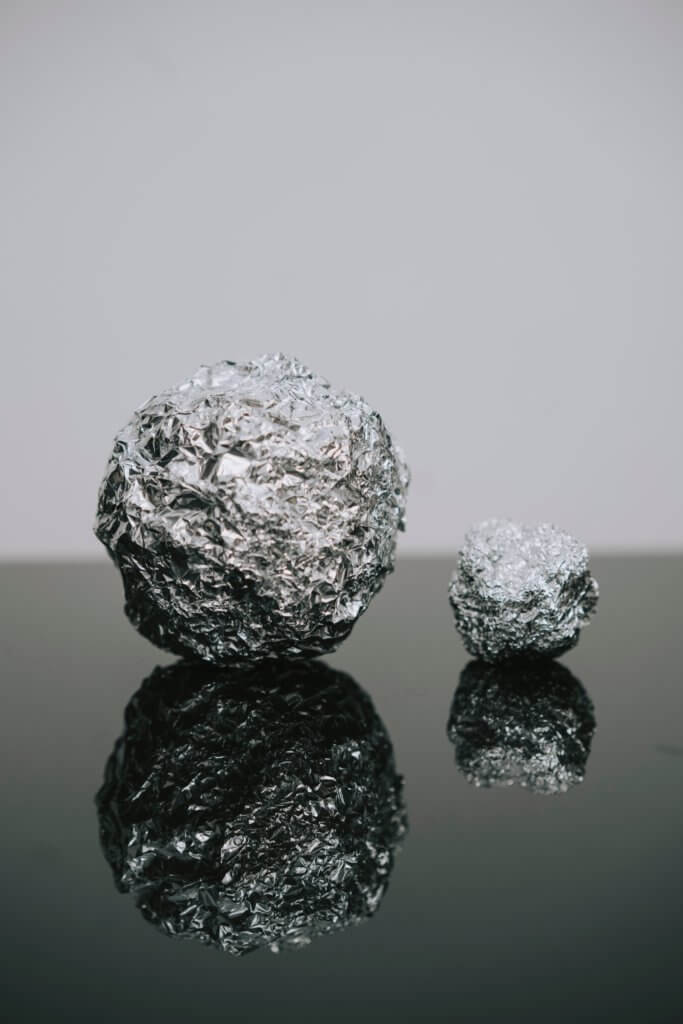
Does Aluminium Foil Block EMF Radiation?
With the proliferation of wireless products in the home, there is an increased concern over the health risks of EMF radiation. More people are looking for ways to protect themselves and their families from the dangers of radiation in the home. Some believe that aluminium foil protects against this type of radiation, which would be great as it is a cheaper alternative to other EMF blocking devices. But is this claim accurate? How can we know that foil is effective at blocking harmful rays? We have researched this topic, so you don’t have to, so keep reading to find out more.
Does Aluminum Foil Protect Against Radiation?

The short answer is yes, kitchen foil made from aluminium blocks radio frequency waves. This is because the aluminium material conducts electricity, forming a barrier which is like a Faraday cage, blocking out most radiofrequency waves. A quick way to prove that this is effective is by wrapping up your mobile phone in the foil. Try calling it and you will notice that it has no signal, meaning that the foil is blocking the waves.
Does foil thickness matter?
Aluminium foil can come in a variety of thicknesses, some more affordable than others, so does the thickness of the foil matter? If we are thinking about EMF radiation or most radiofrequency waves, the answer is no. The thickness of the metal is not the determining factor in protection from these waves, instead, it is that there are no holes in the foil that are larger than the shortest wavelength of the waves that you are wanting to block.
It is important to note that while foil blocks EMF radiation and other types such as microwave radiation, it does not absorb it or draw it in. The radiation travels in straight lines so, to be fully protected, the foil needs to be directly between the foil and your body. One other issue is that EMF or WiFi rays in the home will simply bounce off aluminium, meaning that they will still be present around your home. Be wary of this when choosing how to use aluminium foil in your home as it may not be entirely effective.
How To Test If Aluminium Foil Is Actually Working?
The best way to test if any foil that you have placed in your home is effective is by investing in a quality EMF meter. This will then allow you to measure EMF radiation levels without the aluminium foil, and with it, allowing you to see whether it is making a difference.
If you are unsure of which EMF reader to purchase, then take a look at our article on the best EMF Meters and Detectors. This will give you great information on how to use EMF meters, and gives you some great products that can be purchased easily through Amazon. These readers are portable and can be used throughout your home to identify radiation hotspots in your home.
How To Use Foil To Protect Your Home

Aluminium foil can be used in a variety of different ways around your home to protect yourself and your family. We have listed a few ideas below to get you started:
Create a small Faraday cage
If you are looking to create a DIY Faraday cage that you can put objects in, then tinfoil is a great material to use. Use the foil to line a cardboard box such as a shoebox on all sides, the bottom and the roof. Do not tear the foil as this will let EMF rays through, instead try using tape or glue to ensure that it stays in place. This homemade cage can be used to store electronics when you are not using them, blocking any EMF radiation that is emitted from them.
Turn off your WiFi
When your Wifi router is not needed, it is best to turn it off to make sure that EMF radiation is not pouring out of it and into your home. If you are unable to do this at the power source, a great way to block out EMF radiation is to put a box over it, covered in aluminium foil like the Faraday cage above. You can then slip this box over your router when it is not in use, to stop these EMF rays for periods of time. Studies have shown that long term exposure to radiofrequency waves can lead to health issues, so reducing your exposure when you are not using it, for example overnight, can be extremely beneficial.
Educating your Kids
Helping your children understand more about radio waves and how to block them can be fun and entertaining. You can use aluminium in your home to conduct mini experiments with them. Use the foil to cover devices such as a mobile, or a remote and measure the difference in EMF levels using the EMF meter that we mentioned above. If your child has any remote-control toys, show them the difference in the controller, and let them try and drive it with the foil over the remote. This will mean that they are learning and understanding more about EMF radiation.

Alternatives To Aluminium Foil
Aluminium foil has its advantages – it is inexpensive, effective and can be added to your home easily without complicated fitting by an expert. It is the ultimate DIY product, however, there are some alternatives that can create similar Faraday cage effects. Iron and Steel are both materials that help block out EMF rays, and are often used in metal framing for buildings – this is why you can’t get a signal in some areas. Copper also works well – check out our blog post on this here. If you are looking to block a particular device in your home, such as a Smart Metre, then take a look at our article on this here.
Conclusion
Aluminium foil is a great and affordable way to block EMF radiation in your home, however, it has to be used correctly to be effective. For more ways to protect your home from EMF radiation, check out the other articles in our blog.
